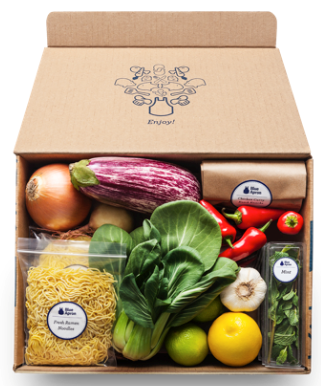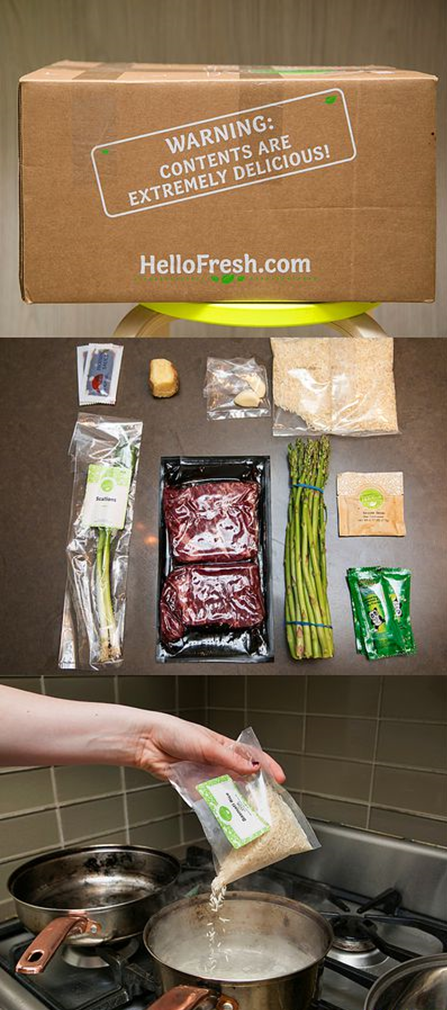BY: ALEX PIERCE-FELDMEYER
Let us all rejoice! Why? Meal subscription plans. Now that meals can be shipped to our doorstep, those of us with busy schedules (or who choose not to or cannot cook) can breathe a sigh of relief. These meals take convenience to a new level by arriving with all the ingredients (pre-measured/portioned) and directions needed to prepare them. I will admit, I myself am not a meal subscriber. My reasons for not subscribing:
1) I love the grocery store way too much to give up going there
2) My love for grocery shopping is so intense that, even if I save money with meal subscriptions, I would still end up going to the grocery store…inevitably spending even more money
3) I snack—a lot, enough that it would totally defeat the concept of saving money using these highly touted meal plans.
But alas, I know a lot of people out there adore their meal subscriptions. Thus, I am here to report on some of the lesser-discussed/ publicized aspects to these meal plan clubs. I investigated, listened to discussions, and informally interviewed friends and colleagues who had experiences with meal subscriptions, specifically Hello Fresh and Blue Apron.

image source: https://www.theverge.com/2016/5/25/11763286/blue-apron-vs-plated-hello-fresh-box-meal-delivery-cost-reviews
What did I learn you ask?
The Basics:
I began my investigation by studying what plans each subscription service offered. Both seemed fairly similar. They were either offering meal plans for either 2 or 4 people where you pick 3 meals for a week’s (7 day) subscription. With that being said, 3 meals over a week do not cover all of your consumption needs. You do still need to fill in the blanks, e.g. breakfast, lunch and remaining dinners. The price per meal varied, but $9.99 per meal is the average meal price for both subscription services. Both services offer vegetarian options and the ability to ‘personalize’ your meals, by selecting 3 of the 6 meals offered for that week’s delivery.
Packaging & Delivery
When the meals arrive, they are neatly packaged with pre-measured ingredients in their own separate packaging. Meals are accompanied with recipe cards that utilize pictures and typed directions to ensure a seamless cooking process. Though convenient to the consumer, all this extra packaging suggests it may not be as sustainable as they market. This is considered a, ‘consistent complaint,’ but leaders of the meal plan movement are confident that the attention their products receive will push for more sustainable packaging technology to be developed. However, the price has some arguing, “it isn’t sustainable for the majority of the population.”1
On the flip side, pre-portioned meals are creating less waste for someone who often prepares too much food only to throw out what they fail to consume. However, if someone purchases reusable/bulk ingredients and diligently eats leftovers, I would propose the extra packaging of subscriptions might prove more wasteful in the long run.
Perceived Benefits…
Meal plan subscriptions could be more cost effective for people that often don’t have the time to shop or cook for themselves and thus, resort to frequently eating out at restaurants. The money and time saved on grocery shopping might make the subscriptions worth the price they cost, depending on where you live. It is an ideal plan for people living in cities when meal preparation is complex. It’s not as easy as driving to the grocery store and loading up the back of your car for the next 1 or 2 weeks when you live in a 5th floor walkup in the heart of Chinatown. The subscriptions may also benefit those that are less knowledgeable, but care, about nutrition and diet diversification by allowing them to become more familiar with the variety of meals that they can create. The diversity of the meals (and the fact you can keep the recipes) is appealing for many and, for some, the sole reason why they subscribe to the meal service in the first place.
It is worth noting how ‘trendy’ meal subscriptions are. Giving you a pretty package with detailed pictures and helpful directions sure makes your meal prep and final product picture (even Instagram) worthy. It can be quite satisfying to create a meal that is identical to the picture on your recipe. The genuine feeling of self-fulfillment and a couple likes on Instagram may be valid reasons to subscribe!
Common Gripes…
Picky eaters, beware!
This is great for those that enjoy trying knew things or have diverse palate preferences. However, for picky eaters, there is likely something in each plan that they would either never try or are already on the fence about, nodding to the resonating theme that, meal subscription plans are great, for the right people!
Flavor right for everyone?
Another (perhaps the most vital) aspect of these meals revolves around their flavor profiles. As mentioned, people differ. This means our tastes and preferences also vary. While the meal plans do offer the customers the ability to choose their meals, the recipe for ‘soy-marinated steak with peanut sauce’ might not satisfy someone’s ideal level of soy and peanut flavor. When it comes down to it, the flavor and satisfaction we gain from a meal is the driving force behind our decision to choose to consume it.
Define ‘easy’ meal preparation
I imagined these subscription services to be simple and convenient. Well, convenient and simple perhaps means that it’s convenient because you don’t have to go to the grocery store and simple because everything is somewhat handed to you and pre-measured. However, many first-hand reports from colleagues using the services all agree that it is not a fast or extremely simple process. The recipes take time to read and require some level of skill (as well as the proper tools) to prepare the meal. This is great for the budding cook, but do not let the simple delivery of meals to your door trick you into thinking you do not need to do work, you do! But work isn’t necessarily a bad thing…you learn how to cook new recipes, refine different cooking preparation skills, and may even pick up some new kitchen gadgets in the process. But if, at the end of your day, you need someone to spoon-feed your meals to you, this might no be your ideal purchase.

image source: https://www.blueapron.com/users/sign_up
Food Safety concerns
Last, but definitely not least, I have some qualms with the food safety aspects of meal delivery. I don’t think anyone can be sure these foods are handled/transported in the proper manner, even if they arrive insulated in ice packs. Food ingredients are diverse; some travel well while others do not. Even if trials are run and the inside of the box temperature does not change, inevitably the weather will. Are we sure the proper storage and handling conditions of the products during transportation are maintained and consistent? It is much easier to regulate the inside temperature of the grocery store in the hopes that the customer’s transport of purchased items to their home is adequate, but to instill confidence in a shipping process is somewhat disconcerting.
Also I do wonder how well subscription services market things with scientific accuracy, rather than leading with emotion, touting terms like ‘all natural,’ and ‘organic’. These are controversial topics, and while ubiquitous, may alienate people or cause confusion among those purchasing the services. Billy Roberts, a Senior analyst on Food and Drink from Mintel commented,
“Certain consumer demographics are embracing the organic claim on foods and beverages, but this is found significantly more in younger consumers and parents. Other consumers appear to lack trust in the organic label, and the lack of a uniform regulatory definition for “natural” in most foods could negatively impact consumer regard for the term going forward. Organic, while relatively clearly defined from a regulatory standpoint, appears largely misunderstood by consumers, suggesting brands could benefit from increasing awareness of exactly what the organic label represents and the strict requirements in attaining the claim.2”
This leads me to the overarching theme of this article…I think these meal services are great, but only for certain people, like most goods or services offered. People have a diverse set of dietary requirements, lifestyles, and moral values, which means there is no “one size fits all” answer to their needs.
In conclusion, these subscriptions are exciting and, much like any product or service, definitely worth the cost for certain people. I, for one, am always excited about a new product merely for the thrill of experiencing new things. It will be fun to watch these companies evolve and see where they end up in the next couple years!

image source: https://www.theverge.com/2016/5/25/11763286/blue-apron-vs-plated-hello-fresh-box-meal-delivery-cost-reviews
References
- https://www.nytimes.com/2016/04/06/dining/meal-delivery-service-subscription-boxes.html
- Mintel (2017) The Natural/Organic Food Shopper-U.S. Mintel






Leave a Reply